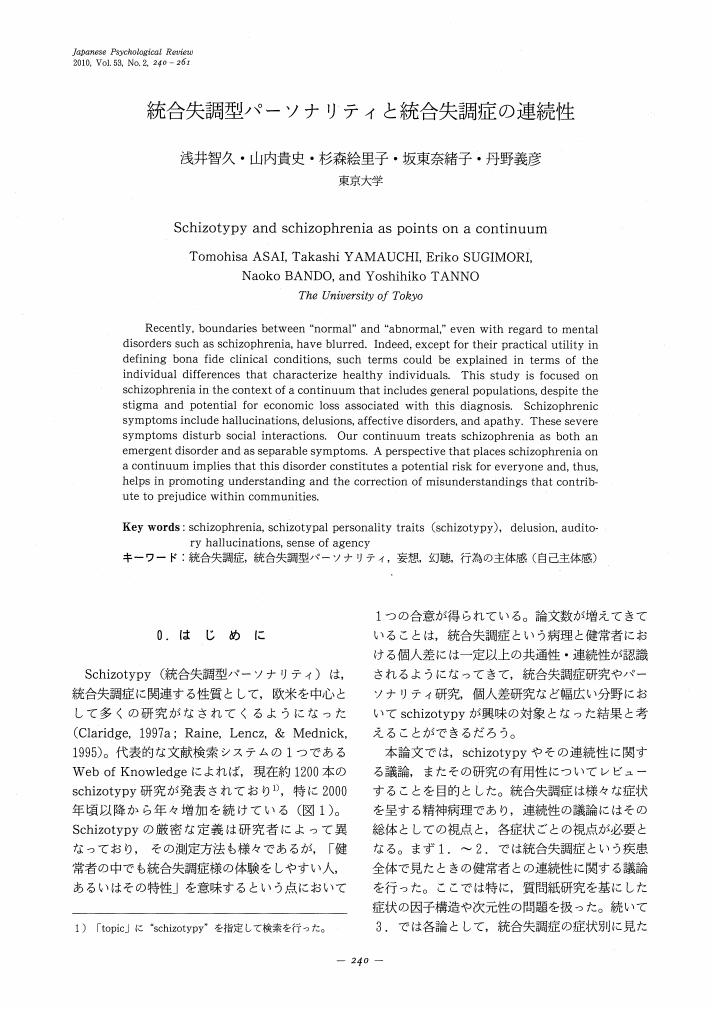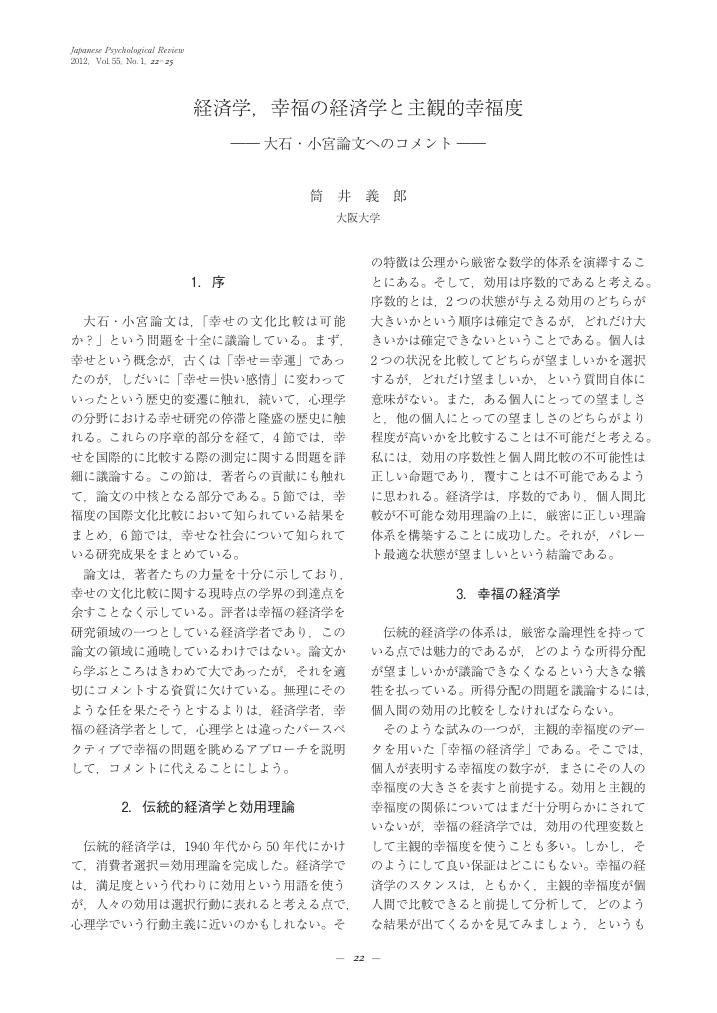- 著者
- 鈴木 江津子 岡田 隆
- 出版者
- 心理学評論刊行会
- 雑誌
- 心理学評論 (ISSN:03861058)
- 巻号頁・発行日
- vol.56, no.2, pp.310-319, 2013 (Released:2018-08-18)
3 0 0 0 病気の理解における科学的・非科学的信念の共存
- 著者
- 外山 紀子
- 出版者
- 心理学評論刊行会
- 雑誌
- 心理学評論 (ISSN:03861058)
- 巻号頁・発行日
- vol.58, no.2, pp.204-219, 2015
2 0 0 0 OA 室内の物理的環境から対人認知・行動への潜在的影響過程
2 0 0 0 OA 犯罪者プロファイリングはホームズの叡智を獲得したのか?
- 著者
- 桐生 正幸
- 出版者
- 心理学評論刊行会
- 雑誌
- 心理学評論 (ISSN:03861058)
- 巻号頁・発行日
- vol.61, no.3, pp.344-358, 2018 (Released:2020-01-18)
- 参考文献数
- 58
In recent years, offender profiling research has played a substantial role in criminal psychology. To date, criminal etiology and the psychology of delinquency have been the focus of criminal psychology. These methods were demonstrated to be useful in criminal investigations involving psychological analysis of criminal behavior. This may be evaluated as taking after the reasoning method of Sherlock Holmes, the fictional master detective. This article discusses the historical development and present state of offender profiling and its future, with reference to the Sherlock Holmes period and reasoning method. The history of criminal profiling can be broadly divided into three periods: before the FBI (the period of Holmes); the development and implementation of FBI methods; and the current period, in which statistics are used. This can also be called the history of transition from a period that focused on psychiatry and clinical psychology to one focusing on social psychology and environmental criminology. The main analyses of this method are “linkage analysis,” “criminal profile assumption,” and “geographical profiling,” as well as statistical analyses, which comprise multidimensional scaling and decision trees, among others. In modern-day Japan, analytical findings from offender profiling are used in investigating officers’ decision-making in the same way as eyewitness reports, information regarding criminal techniques, and information obtained from forensic data. Psychological techniques have been utilized in the criminal investigation setting since “polygraph tests” that test for the presence or absence of recollection. However, currently, analytical findings are provided only as investigation support information, which can hardly be described as ideal. In general, criminal profiling has not reached the wisdom displayed by Holmes. Ideal criminal profiling entails an “investigating officer” deciding on an investigation plan founded on various types of analytical information. This practice demonstrates “abductive reasoning,” wherein the truth is uncovered while a hypothesis is being repeatedly formulated. This necessitates future methods entailing statistical abductive reasoning using Bayesian inference, among others, and a multi-disciplinary research environment.
2 0 0 0 OA バイリンガルの言語発達について
- 著者
- 久津木 文
- 出版者
- 心理学評論刊行会
- 雑誌
- 心理学評論 (ISSN:03861058)
- 巻号頁・発行日
- vol.49, no.1, pp.158-174, 2006 (Released:2019-04-12)
- 被引用文献数
- 2
2 0 0 0 OA ワーキングメモリと発達障害 ―支援の可能性を探る―
- 著者
- 湯澤 美紀
- 出版者
- 心理学評論刊行会
- 雑誌
- 心理学評論 (ISSN:03861058)
- 巻号頁・発行日
- vol.54, no.1, pp.76-94, 2011 (Released:2018-08-18)
- 被引用文献数
- 1
2 0 0 0 OA 孤独感と対人環境の再帰的構築
- 著者
- 五十嵐 祐
- 出版者
- 心理学評論刊行会
- 雑誌
- 心理学評論 (ISSN:03861058)
- 巻号頁・発行日
- vol.63, no.4, pp.403-417, 2020 (Released:2022-02-05)
- 参考文献数
- 108
Tackling loneliness is a challenging task in modern society. Recent research has focused primarily on the physiological nature of loneliness. However, the multifaceted psychological construct is clearly more than just a negative emotion. The virtue of helping each other can be undermined by the process in which loneliness breeds maladaptive social perception and behavior that also facilitate the avoidance of lonely individuals. To cut off the vicious cycle of loneliness, comprehending the dynamic nature of loneliness and social networks through the lens of social information processing is important. After introducing the conceptualization of loneliness, this paper discusses the process by which individuals feel isolated in dyadic/networked social connections, the social selection and influence mechanisms of loneliness, the distinction between loneliness and solitude, the current advances and limitation of loneliness interventions, and the importance of providing opportunities for social interactions for the lonely to deal with this modern disease.
2 0 0 0 OA キャリア心理学における偶発理論 ――運が人生に与える影響をどのように考えるか――
- 著者
- 下村 英雄 菰田 孝行
- 出版者
- 心理学評論刊行会
- 雑誌
- 心理学評論 (ISSN:03861058)
- 巻号頁・発行日
- vol.50, no.4, pp.384-401, 2007 (Released:2019-04-12)
2 0 0 0 OA 隠すことの心理生理学:隠匿情報検査からわかったこと
- 著者
- 松田 いづみ
- 出版者
- 心理学評論刊行会
- 雑誌
- 心理学評論 (ISSN:03861058)
- 巻号頁・発行日
- vol.59, no.2, pp.162-181, 2016 (Released:2018-04-13)
- 参考文献数
- 113
- 被引用文献数
- 12
Deception, especially unexpressed deception, concealment, is difficult to detect from words and behavior. Thus, psychophysiological approaches are used to detect deception. One such approach is the Concealed Information Test (CIT). The CIT is used in criminal investigations to examine a subject’s concealing of a memory through autonomic and/or central nervous activities. In contrast, psychophysiologists generally infer cognitive processes from physiological responses. This study aimed to reveal the cognitive processes of concealing the memory by reviewing physiological responses during the CIT. We demonstrated that the intent to conceal memory (or withdrawal motivation) would increase the significance of the memory and recruit controlled processes, such as monitoring and inhibition of physiological responses.
2 0 0 0 OA 統合失調型パーソナリティと統合失調症の連続性
2 0 0 0 OA なぜ人は助け合うのか ―利他性の進化的基盤と現在―
- 著者
- 小田 亮
- 出版者
- 心理学評論刊行会
- 雑誌
- 心理学評論 (ISSN:03861058)
- 巻号頁・発行日
- vol.63, no.3, pp.308-323, 2020 (Released:2022-02-05)
- 参考文献数
- 84
- 被引用文献数
- 1
Traditional psychology has primarily focused on the mechanism and development of human altruism. However, the functional significance and evolutionary origin of altruism are also important. The condition for altruism to evolve by natural selection is “positive assortment.” To guarantee positive assortment, variance within a group must be small, whereas variance between groups must be large, which results in “parochial altruism.” Some features of reasoning and memory in humans are believed to have been adapted to parochial altruism. However, humans sometimes show “generalized altruism” beyond each group they belong to. Clarifying the relationship between the function of the mind as a legacy of evolution and the structure of human social groups is important to understand altruism.
2 0 0 0 OA 真の自己としての表面的な自己
- 著者
- 河野 哲也
- 出版者
- 心理学評論刊行会
- 雑誌
- 心理学評論 (ISSN:03861058)
- 巻号頁・発行日
- vol.57, no.3, pp.337-349, 2014 (Released:2018-07-13)
2 0 0 0 OA 学生はなぜ質問をしないのか?
2 0 0 0 OA 青年の恋愛行動の構造
- 著者
- 松井 豊
- 出版者
- 心理学評論刊行会
- 雑誌
- 心理学評論 (ISSN:03861058)
- 巻号頁・発行日
- vol.33, no.3, pp.355-370, 1990 (Released:2019-07-24)
- 著者
- 西田 裕紀子
- 出版者
- 心理学評論刊行会
- 雑誌
- 心理学評論 (ISSN:03861058)
- 巻号頁・発行日
- vol.63, no.1, pp.78-81, 2020 (Released:2021-07-27)
- 参考文献数
- 15
2 0 0 0 OA 感情制御の神経基盤 ――腹側前頭前野による扁桃体活動のコントロール――
- 著者
- 大平 英樹
- 出版者
- 心理学評論刊行会
- 雑誌
- 心理学評論 (ISSN:03861058)
- 巻号頁・発行日
- vol.47, no.1, pp.93-118, 2004 (Released:2019-04-12)
- 被引用文献数
- 1
2 0 0 0 OA 経済学,幸福の経済学と主観的幸福度 ―大石・小宮論文へのコメント―
- 著者
- 筒井 義郎
- 出版者
- 心理学評論刊行会
- 雑誌
- 心理学評論 (ISSN:03861058)
- 巻号頁・発行日
- vol.55, no.1, pp.22-25, 2012 (Released:2018-08-18)
2 0 0 0 OA 母子関係と間主観性の問題
- 著者
- 鯨岡 峻
- 出版者
- 心理学評論刊行会
- 雑誌
- 心理学評論 (ISSN:03861058)
- 巻号頁・発行日
- vol.29, no.4, pp.506-529, 1986 (Released:2019-07-24)
2 0 0 0 OA 援助要請の諸相と陥穽 ―中谷・岡田論文と永井論文へのコメント―
- 著者
- 橋本 剛
- 出版者
- 心理学評論刊行会
- 雑誌
- 心理学評論 (ISSN:03861058)
- 巻号頁・発行日
- vol.63, no.4, pp.497-502, 2020 (Released:2022-02-05)
- 参考文献数
- 7
- 著者
- 永井 智
- 出版者
- 心理学評論刊行会
- 雑誌
- 心理学評論 (ISSN:03861058)
- 巻号頁・発行日
- vol.63, no.4, pp.477-496, 2020 (Released:2022-02-05)
- 参考文献数
- 153
This article reviewed three help-seeking issues in counseling and in clinical psychology research: (1) help-seeking processes, (2) facilitation of help-seeking, and (3) help-seeking and adjustment. Based on a review of previous literature about help-seeking processes and the facilitation of help-seeking, the importance of integrating perspectives that combine theoretical models of help-seeking, factors influencing help-seeking, programs facilitating help-seeking, and clinical practice was indicated. With regard to help-seeking and adjustment, help-seeking may not always serve an adaptive function and practices that aim to facilitate help-seeking have several considerations. Finally, the conclusion of this article is that future studies should consider the impact of sociocultural factors on help-seeking.












